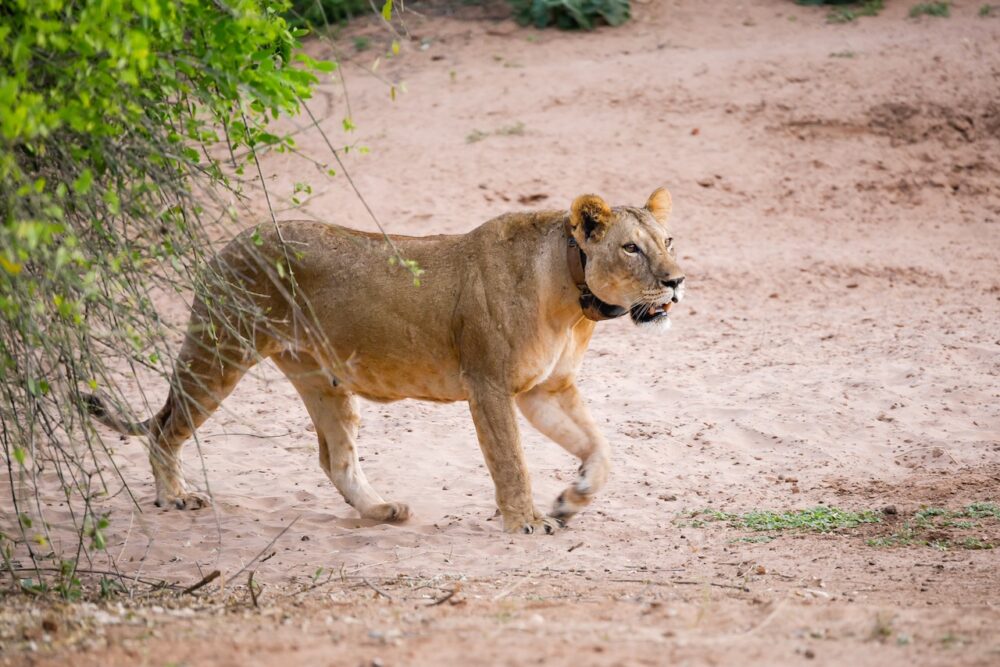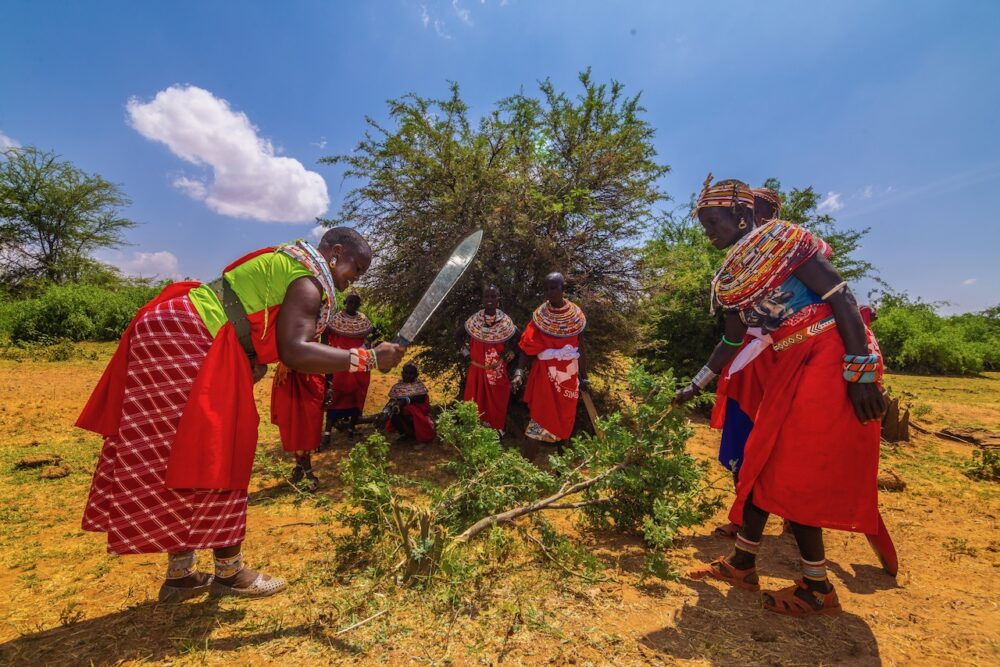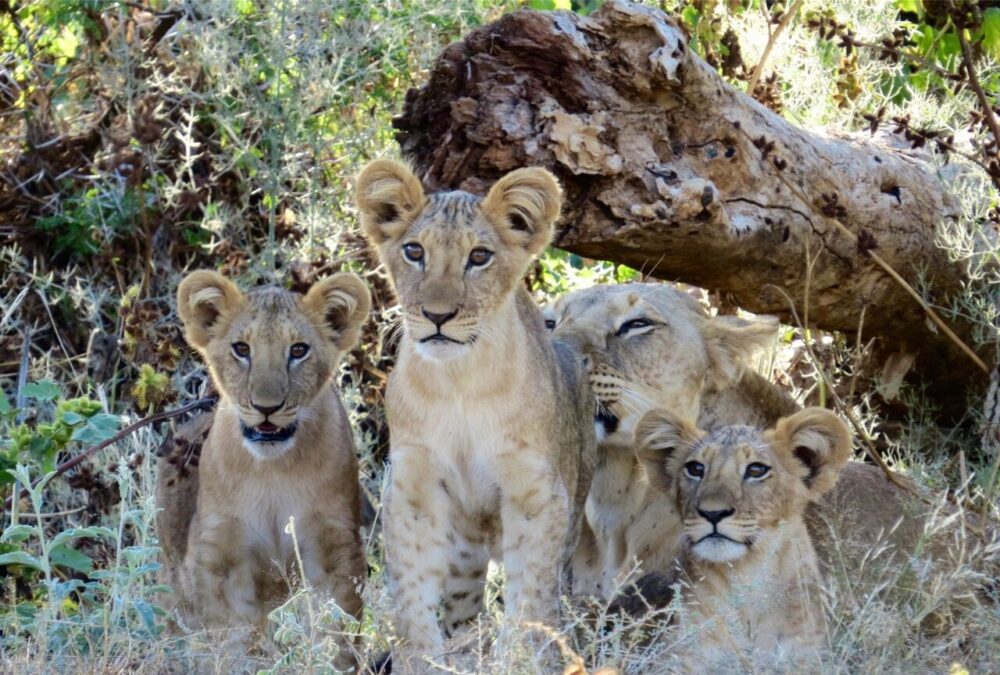The following article by Ewaso Lions’ own Paul Thomson first appeared on PBS’ NOVA Next on April 2, 2014 with the title Coexisting with Carnivores – Why It’s Not a Zero-Sum Game.
It was late in the summer, and the two young lions had been on a camel killing spree. Over a period of three months, they had entered the villages of the Samburu people at night and killed ten prized camels.
It wasn’t long before they paid the price. One hot, hazy day in early September, when the male lions were napping under a scraggly acacia tree, a group of five young men came upon them. The men fired their AK-47s. Lguret, whose name means “cowardly,” ran off. Loirish, who was the more aggressive of the pair, may have stood his ground. He may even have tried to fight back, but he was no match for the rifles.
Then the men butchered Loirish. They used their knives, adorned in colorful plastic as all Samburu warrior knives are, to cut off the lion’s head and feet. Then they took Loirish’s head and burned it in a small fire, an unusual act that was probably meant to destroy the GPS tracking collar we had placed on him to track his movements so we could warn herders. By the time we got to the grisly site, Liorish’s feet were missing. The men had taken them, perhaps to be sold on the growing black market for traditional Chinese medicine.
Letoiye, a member of the Samburu tribe and a part of our field team which had been tracking Loirish up to that day, stared at the blackened head in the pit and asked no one in particular, “Why did they kill my lion?”
Warrior Watch
Liorish unfortunately shares his fate with a growing number of large carnivores around the world who have clashed with humans and didn’t survive. Of the 31 large carnivores species like him—including lions, tigers, cougars, wolves, and snow leopards—most live not in some pristine wilderness, as we’d like to believe, but in landscapes dominated by humans and their activities. As a result, these animals are caught in a struggle between two sides of humanity—the one that wants large carnivores preserved and the other that would like to see them eliminated.
Letoiye is a Samburu moran, or warrior, a group that has traditionally been neglected in conservation. He never went to school and instead roamed the countryside tending to his family’s livestock while keeping a watchful eye on the land around the village. Despite their lack of formal education, Letoiye and his fellow moran possess skills that are the envy of many biologists and wildlife authorities. Because their job is to ensure their community’s security—which in rural East Africa often involves watching for predators—the moran know an impressive amount about lions and other predators.
Warriors like Letioye inspired us to set up Warrior Watch four years ago. They offer an intimate knowledge of the landscape and how lions and other wildlife move throughout it. In return, we teach Letioye and his peers how to identify each lion’s unique whisker spot pattern and how to discuss carnivore issues with fellow Samburu. We also offer weekly lessons on reading and writing in English and Kiswahili.
Before Warrior Watch, it wasn’t uncommon for moran to hunt and kill lions without question from their peers. But now, this program and others in Kenya are proving that attitudes towards lions and other large carnivores can change. A recent study of the program showed that participating warriors and their communities had a higher tolerance of lions and better understanding of their value.
The situation in the United States is not much different from the Samburu in Kenya. In California in 2013, for example, the state’s Department of Fish and Game issued 148 permits to eliminate cougars that had killed livestock and pets. As the suburbs expand out into once-wild areas, cougars are becoming more common in people’s backyards, where they occasionally kill goats and pets. While our livelihoods don’t always depend on our animals in the same way that the Samburus’ rely on their livestock, cougar-human clashes in California illustrate a broader point. The U.S. and Kenya share a bond that is at the heart of human-carnivore conflict: we both kill carnivores when we perceive them as threats to things we value.
Population at Risk
The reality is, of course, that we are a far greater threat to carnivores than they are to us. The cougar, for example, was all but eliminated from the eastern half of the United States during the 20th century. And in Africa, in the last half a century, the number of lions roaming in the wild has declined from 200,000 to fewer than 35,000. That’s mostly due to habitat destruction by humans. Lions used to roam most of the continent. Today, they occupy just 20% of their original territory, scattered across the continent and separated by cities, highways, villages, and farm fields. Some live on reserves, but that protected area isn’t enough to cover lions’ still expansive home ranges.
A large number of conservationists favor creating more protected areas like national parks and reserves. After all, the largest intact populations of lions live in Selous and Ruaha National Parks, giant expanses of land under protection in Tanzania. These parks not only protect lions, they also support the entire ecosystem, fostering healthy savannahs that nurture gazelles and other prey species that keep lions sated. They also generate income through tourism, a not unimportant fact in many impoverished regions.
But protected areas haven’t been a panacea for large carnivores. As in the U.S., most African parks do not offer complete protection. Poachers have infiltrated many parks specifically to go after lions, while herders grazing their livestock inside park boundaries inadvertently take resources away from lion prey like gazelles and wildebeest.
Which is why some conservation biologists are suggesting that the only way to truly protect lions is to fully enclose reserves in fences. Yes, this would trap lions inside the parks, but it would also create a physical barrier between them and us. Such a move certainly has the potential to reduce poaching and limit human-animal conflict, but it could also reduce the viability of individual lion populations inside. Large carnivores like lions require expansive ranges to meet their daily needs. Plus, they can suffer from a phenomenon known as bottlenecking when overcrowded, which can lead to higher incidence of genetic disease and inbreeding. Fencing in lions to creating carnivore islands is one tool that might be effective in some cases, but given the potential for problems, it is not a “one size fits all” solution.
Building Tolerance
A better solution is to raise the tolerance of the land—and the people—living around protected areas. Lions, cougars, and other large carnivores will be able to live with people if they have safe refuge and as long as we keep ourselves and our property at a safe distance. Yet carnivores don’t belong in every human landscape, so we also need to carefully manage the areas where they can be supported.
That’s why we’re working hard in northern Kenya to create these landscape mosaics where local people can tolerate carnivores. We use a combination of high-tech research activities combined with low-cost community-sourced education programmes like Warrior Watch. This year, we are fitting GPS-enabled tracking collars on ten young adult male lions. By mapping lion movements through the landscape, we can identify key corridors and refuges that might be prioritized for lions. The tracks also let us know which communities are in the lions’ territories so we can reach out to them with programmes like Warrior Watch.

Large carnivores like lions require expansive ranges to meet their daily needs. This lion is wearing a GPS collar to help us track its movements and warn herders.
At the same time, we’re also using the GPS collars to tell herders where the predator hot zones are. That way they can keep their livestock clear, avoiding unnecessary confrontations and losses. We can also track lions like Loirish that are known for killing livestock. When we locate one, our warriors go in to tell the villagers to be especially vigilant.
We can apply these lessons here in the U.S., too. As cougar and other carnivore populations make a comeback, a mixed approach is key. Protected areas are certainly important, since they provide carnivores and their prey with crucial strongholds. But we also need people to develop a tolerance to carnivores if we are to sustain that coexistence.
It’s starting to happen in places like the Santa Cruz mountains where conservation groups, state agencies, academic institutions, and landowners are working together to improve tolerance of cougars. Homeowners are learning how to properly fence their goats to keep them safe from cougar attacks, which can reduce the need to kill cougars in retaliation. And local governments are installing culverts under roadways to let cougars cross highways without risking dangerous collisions with vehicles. There are other innovative measures, too, like the protection of a forest behind a cement plant that cougars took a liking to. Portions of the plant grounds are open for recreational hiking while the important cougar habitat is being left intact. There’s something for everyone.
Additionally, we need programmes that educate hikers and pet owners as well as ones to work with groups, like the Samburu warriors, that haven’t been a part of traditional outreach programmes.
Finally, the most important thing to remember is that everyone’s point of view needs to be included in the process. It’s useful to keep in mind that the Samburu don’t need to be told how to live with lions—they’ve been doing that for tens of thousands of years—or that Americans don’t like being pandered to. Together, we can figure out how humans, livestock, pets, and wild carnivores can live together in increasingly crowded landscapes.
Not Alone
Back in Kenya, Letoiye remains troubled by the killing of Loirish. In some respects, his new way of thinking clashes with the old ways that many of his people still follow. He no longer sees lions as a threat, but as a unique part of his identity. He feels a responsibility to protect them, and he works everyday to convey a message of coexistence. But not everyone wants to listen. Loirish’s death is perhaps the most vivid reminder of that.
Fortunately, Letoiye’s not alone. Another warrior on our team, Jeneria, once said something that gives me hope: “Lions are in my blood now.” Losing lions is something Letoiye, Jeneria, and their fellow warriors are no longer willing to accept.
Tell us what you think in the comments below or on Twitter #ewasolions and Facebook







